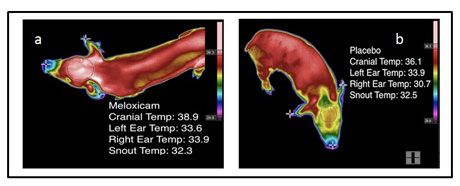Administering pain medication through sow's milk reduces piglet stress, veterinary study finds
Iowa State researchers hope passive administration will encourage more U.S. pork producers to provide pain medication for routine husbandry procedures.

Thermography image illustrating different skin temperatures of piglets who received and did not receive pain medication. Photo courtesy of Dr. Hans CoetzeePork producers may have a way to administer pain medication to piglets without the need to inject each piglet. Hans Coetzee, BVSc, Cert CHP, PhD, DACVCP, professor of veterinary diagnostic and production animal medicine at Iowa State University, carried out a year-long proof-of-concept study that showed the effectiveness of delivering pain medication to piglets through the milk of mother sows.
Coetzee-with colleagues Lock Karriker, DVM, MS, DACVPM, and postdoctoral research associate Jessica Bates, DVM-introduced the pain medication meloxicam into the feed of a sow, which would then be passed on to her piglets through her milk. The results of the study, recently published in the academic journal PLOS ONE, showed that piglets receiving pain medication in that manner experienced less stress after routine castration and tail docking than nursing piglets that received no medication.
“We wanted to find out if we can deliver medications to the piglets passively without having to handle and inject each one individually,” Coetzee said. “Our results seem to demonstrate that this method has the potential to dramatically change how piglets are treated,” Coetzee says in a university press release.
Currently, the United States does not require pork producers to administer pain medication to piglets before carrying out these common husbandry procedures. Further, Coetzee says the U.S. Food and Drug Administration (FDA) hasn't approved the use of any pain medication for piglets.
The researchers illustrated the piglets' response to the pain medication by tracking medication levels in blood samples from both the sows and piglets involved in the study, but also by use of a thermography camera that measures changes in skin temperature. The images showed that the piglets who received no pain medication had a pronounced drop in surface temperature around their heads, which Coetzee says likely resulted from pain causing blood vessels in the skin to constrict and reduce blood flow. Further, Coetzee says piglets that received pain medication through milk maintained a more consistent surface skin temperature, indicating those piglets were under less stress.
This new method of drug administration could encourage more American pork producers to provide pain medication to piglets, as is required in the European Union, university officials say. “We have to refine the process and make it cost effective, because this method has immense potential in assisting the swine industry in addressing pain associated with routine management procedures,” Coetzee says. “It's possible it could be used for other drugs a producer might want to use to medicate piglets.”
FDA approves oral drug for broad canine protection against parasites
October 7th 2024Elanco's lotilaner, moxidectin, praziquantel, and pyrantel chewable tablets (Credelio Quattro) provide a single monthly dose for protection against fleas, ticks, heartworms, roundworms, hookworms, and 3 species of tapeworm.
Read More
dvm360 announces winners of the Veterinary Heroes program
Published: September 6th 2024 | Updated: November 5th 2024This year’s event is supported by corporate sponsor Schwarzman Animal Medical Center and category sponsors Blue Buffalo Natural, MedVet, Banfield Pet Hospital, Thrive Pet Healthcare and PRN Pharmacal.
Read More